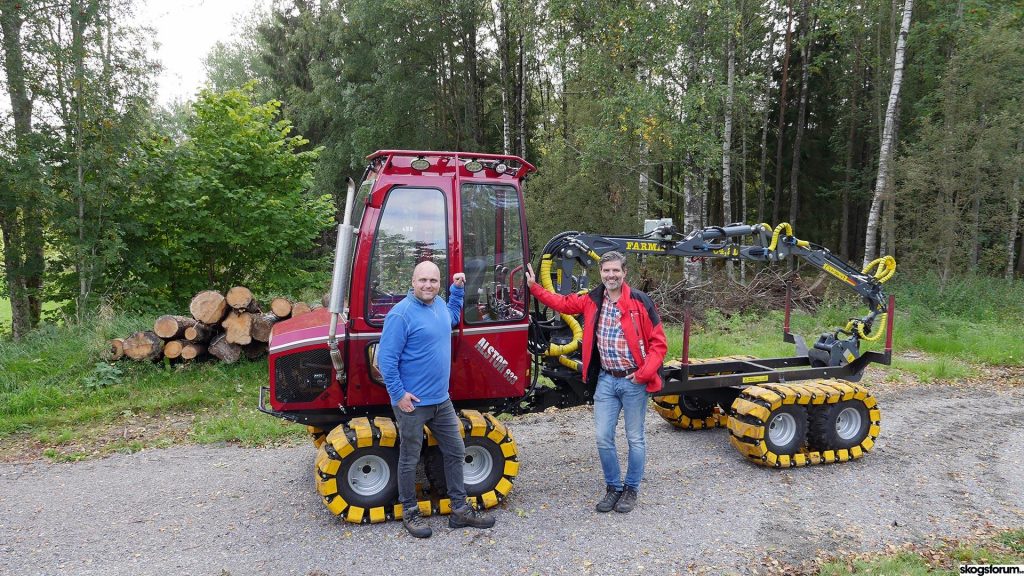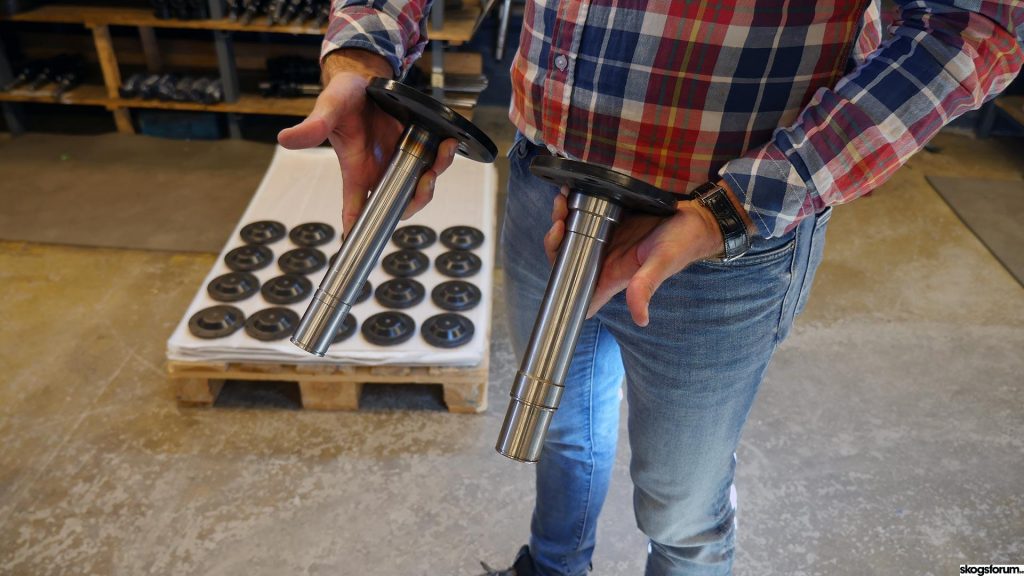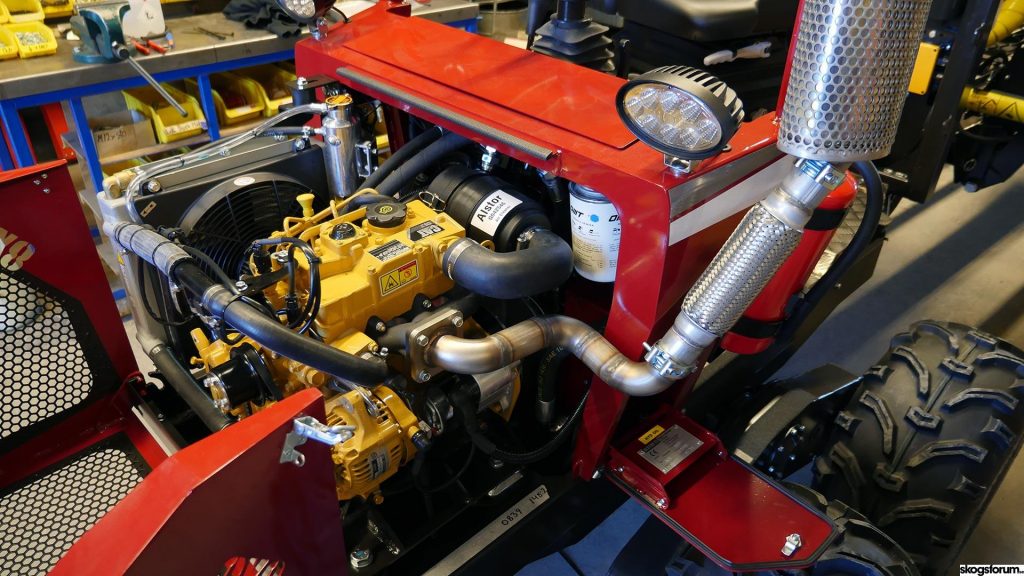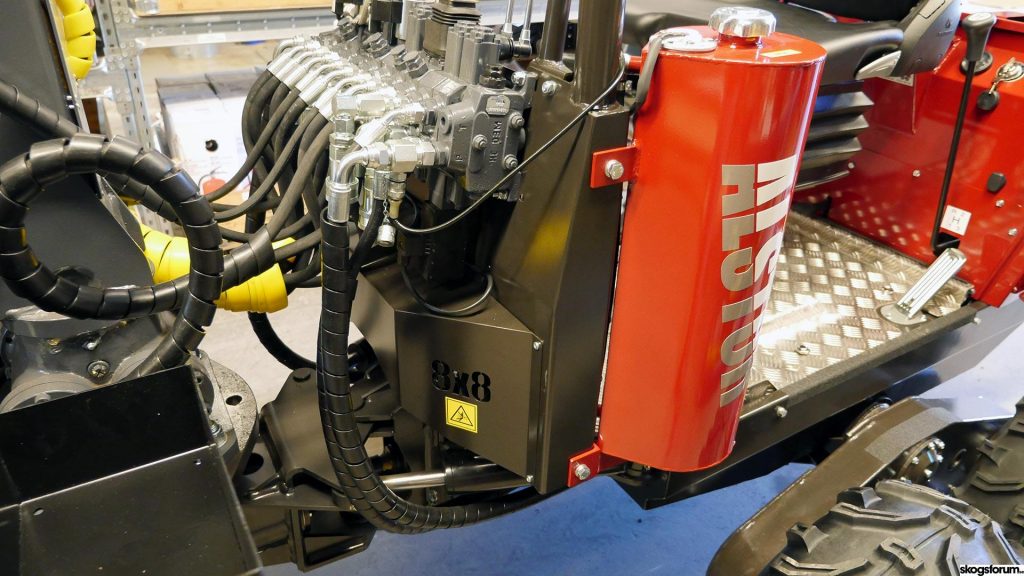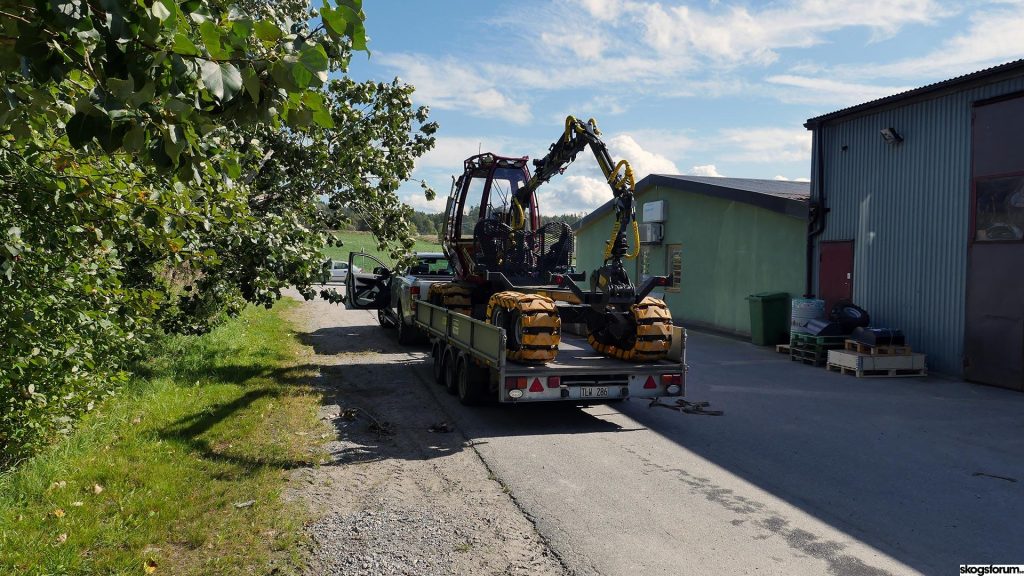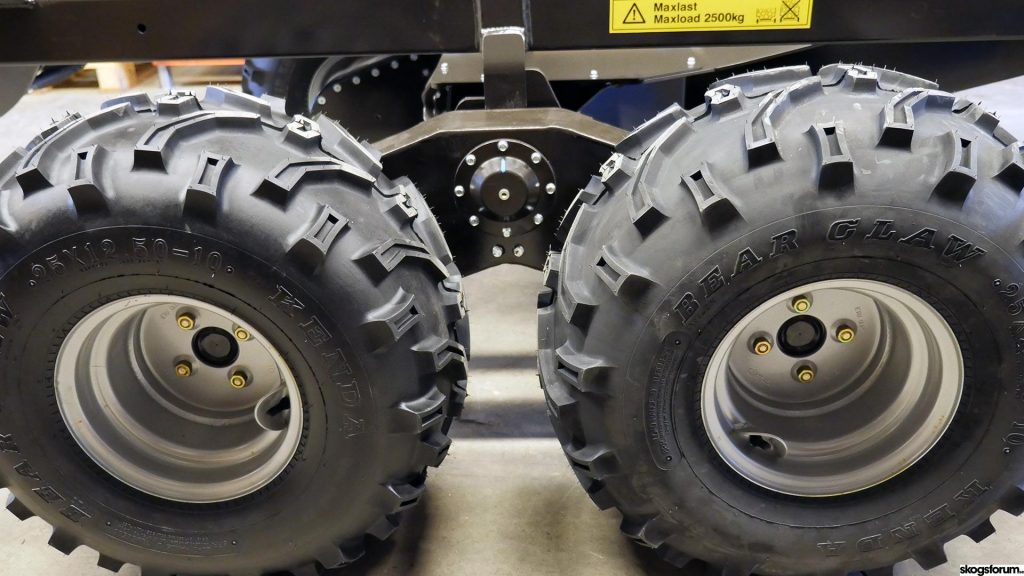NordicWoodJournal.com has visited Alstor in Dingle, Sweden, a company that, among other things, is manufacturing the popular mini-forwarder Alstor. We received a history lesson, a visit to their factory and the opportunity to test drive an Alstor 833 in its true element – the forest. So come along and keep reading, check out the photos and enjoy the video at the end of the article.
What is a mini forwarder?
If you’re not aware, here’s a quick overview of what kind of product we’re talking about. A forwarder is a forest machine designed to collect timber in the forest – that is, woods that has already been cut down by either a harvester, manually, or by tractor processor or similar. A mini forwarder is like a regular forwarder but in a smaller format. The Alstor described here can load up to 2,5 ton of timber. It can be compared to a traditional forwarder for thinning projects which can carry 10 tons or more. The Alstor is around 1.53 meters wide compared to about a meter more for traditional forwarders. A traditional forwarder in a smaller size, in other words.
History about the Alstor
Lars Jansson, father of the current CEO and owner, Kristian Laurell, founded Bohus Traktor in Dinge in the 60’s. During the 80’s and early 90’s, the focus was on selling to and serve the agricultural sector of the region. Upon entering the EU, Lars realized that this sector wouldn’t develop at the speed he wished to carry on his own business in. Therefore, he began looking at other fields and the forest was close at hand. In the mid 90’s Lars got in touch with another Lars, Lars Byström in Nössemark. He had built a terrain vehicle with eight wheels primarily to be used by emergency services during calls to difficult terrain. Lars Jansson immediately saw the potential of attaching a forest crane and timber frame to this machine and bought the rights to the machine. That’s the start of the Alstor and around 1996 the company of the same name was founded, in the same facilities that once hosted Bohus Traktor.
In the early days it was a challenge to reach new customers and make a mark on the market. Lars decided to do a trip up north in Sweden with the Alstor. He showcased and demoed it wherever he could find an audience. The final demo was made in the Kiruna area where forest owners were given the opportunity to buy the demo machine itself with the rights to return it for a refund. Lars called the customer back some time later to ask if it was time to come and collect it, but the forest owner was more than happy with the machine and wanted to keep it!
Already from these early days the character of an Alstor was in the machine itself; eight wheels, drive on all eight, great accessibility and minimal components that can act up or cause issues.
Of course, the machine has evolved over time but the basic concept has remained the same. In the beginning, a Volvo M40 gear box was fitted into the Alstor. The reason was simple, the M40 box is not a complicated piece of engineering but rather a small and light-weight, yet dependable, gear box. The M40 was, among others, also fitted into the 140 Volvo series and is a four-gear, manual gear box. It has since been replaced by a newer model. One of the reasons was that they started being difficult to find as they were no longer being manufactured, and those that remained were often in poor condition.
The variator drive has always been present for the simple reason that it’s simple and functional. The advantage is that you can crawl forward with the machine, and as most people know, this is a huge advantage in the forest. The variator band is the wear-and-tear component of this operational unit. It’s cheap and simple to replace yet still lasts for surprisingly many hours of use.
The name Alstor
The name Alstor begs a few questions. Where does it come from? Like many other manufacturers, with Gremo (GREthe and MOgens) perhaps being the best example, it derives from a play of the names of the founders or owners of the company. Alstor originates from the middle name of the founder Lars Astor Jansson, together with his companion at the start of the adventure, Arne Allan Johansson. Alstor is a combination of Allan and aSTOR. As trivia it can be mentioned that, during the first year, the name was not Alstor but “Sweden 8 by 8”. But now it’s Alstor all the way, it has history, it works internationally and the company also likes the twist that they are “ALsidiga” – a Swedish term meaning versatile – and the word play that “stor” actually means “large” in Swedish; a machine of a small size with a large capacity in the forest.
Various Alstor machines throughout the years
During the 20 years that have passed since the beginning, a natural course of product development has occurred. With the Alstor in particular this may not always be evident on the outside. Here’s an overview of the various milestones of the evolution of the machine:
1996: The first Alstor is built, named “Alstor 8×8” after a year. It comes in to versions, both with a gas engine from Vanguard, 16 and 18 hp respectively.
2005: An upgraded version is released, still named 8×8. This one has a stronger centre section, new and stronger bogie axle, and more.
2006: Alstor 8×8 can be purchased with a diesel engine from Kubota.
2007: Alstor 8×8 can be purchased with a cabin.
2010: Kristian joins as CEO and decides to go all in on the Alstor.
2011: The 800-series is released. A series of improvements are carried out and the Alstor receives dual commands, hydraulic brakes, and more. The gas version is called 810, diesel 820 and the cabin version 830.
2013: Alstor 821 is released. A new Alstor altogether designed to meet the demands of forest entrepreneurs of central Europe. A new, stronger centre section, new bogie axles, and more. With the 821 the diesel engines are replaced by 3-cyl CAT engines (after having used Kubota). The version with a cabin is called 831. The Alstor processor version is also showcased for the first time – Alstor 300, an 821 with a Hypro 300 processor on the carrier.
2015: Alstor 833 with a new cabin is presented. It’s based on the 821 with a new and improved cabin, increasing comfort for the driver.
2016: The Alstor can be purchased with a bogie band in plastic, manufactured in Sweden, to further minimize the ground pressure on sensitive ground. See the video below which shows an 833 with the bands mounted (yellow).
8×8 is 8×8
Alstor are proud of the fact that their machines have high terrain accessibility. Everyone who has visited Elmia and their Alstor hill knows this. The reason for the flexibility is partly the high ground clearance, but primarily that the Alstor doesn’t have any differentials, it’s 100% differential locks all the way!
If we start at the engine the power moves through the variators, one on the motor shaft and one on the drive strap with only the variator band in between. Through the 3-step gear box a 1:1 system takes over with shafts and chains which, through stick shafts, feeds the power into the four bogie axles. The bogie axles have a chain drive down towards each wheel and with this the eight wheel drive is achieved.
That this can’t be done with larger forwarders is due to the power. It’s possible to build a drive strap that doesn’t break under the force of the smaller Alstor engine.
Customer satisfaction
Alstor are known for taking customers seriously. Part of this is the secondary market, with fast deliveries of spare parts, a key factor in their success and to get happy customers who spread the word, causing a “buzz”. Another aspect is the small size of the company, with staff that are truly passionate about the product – a close family, so to speak. And since the Alstor has been created and assembled in their own factory in Dinge, which also houses a service center and service bus, you can discuss potential improvements or issues directly with the owners over a cup of coffee.
The Alstor Cap
Many might not know about this, but there’s something special with a cap from Alstor. Only customers may receive one, period. This way they create a unique network at for example forestry fairs and events – if you spot someone with an Alstor cap, you know that this person drives their own Alstor machine. Many have tried to get hold of an Alstor cap without success and the gang in Dinge hold them tight and only release one when together with a shipment.
The Swedish king drives and Alstor
Alstor can boast about the fact that King Carl XVI Gustaf drives an Alstor. He even has two, to be precise. Both the king and the prince are found of cars and machines and since a couple a of years ago they have enjoyed driving Alstor in the forest.
It is Stenhammar godsförvaltning and Djurgårdens Kungliga skogsförvaltning that each own an Alstor. When making their purchases, the king as part of the decision making process. The choice was an Alstor both times.
Why an Alstor?
This is a question one must ask when given the opportunity. It can carry less than an agricultural tractor with a forest wagon, and it costs more than an ATV with a forest wagon. But perhaps that’s exactly why. Along with the great accessibility and the fact that it’s built for the forest.
Personally I feel that it’s noticeable when test driving. The dual commands and centre section along with the hydraulic system adapted to the crane ensures a bit of a feeling that you’re driving a traditionally forwarder, it’s both quick and flexible, and easy on the ground surface as well as the driver.
65% of the market today is in Sweden. The market is probably spread among a number of forest owners who “live in the forest” and use the Alstor in it, as well as a number of forest entrepreneurs who use the Alstor when working towards customers. The trend shows that the latter group is growing bigger, and that the forest owners take on more external projects, all leading to an increased popularity of smaller forest machines. Urbanization also results in smaller projects being high in demand by entrepreneurs.
Any negative aspects?
Yes, but they’re not necessarily about the Alstor itself. The first is that smaller machines with cranes should have rotator pads as a standard. This increases the production by perhaps 5% and decreases irritation among drivers, who may be used to cushioning. Another aspect is that I wish it was possible to get an EHC mini lever, at least as an additional option. It increased the driver environment considerably and that’s important when using the machine a lot. Not to mention the production which also increases. But on the other hand, it does go against the Alstor philosophy to include as few components as possible that may act up, and if something does act up it should be easy to locate the issue. We’ll see what happens in the future!
The future
A lot has happened in the product development of the Alstor during the past few years. A lot of new models and improvements have appeared, and fine tuning has been made, which has ensured good sales. More than 500 Alstor machines are currently active among customers, around half of which are on the Swedish market. More special tasks, warmer winters and urbanization are contributing factors to an exciting market ahead. It feels like Alstor has taken a bigger step into the segment of professional use and the forest owners are catching on!
It will be interesting to follow not just the Alstor but all Swedish manufacturers in the future, in the forest as well as on Forestry. We should all be proud of the entrepreneurial spirit and creativity in the Nordic countries – it’s something to nourish and take care of!
We’ll end with a video from our visit.






